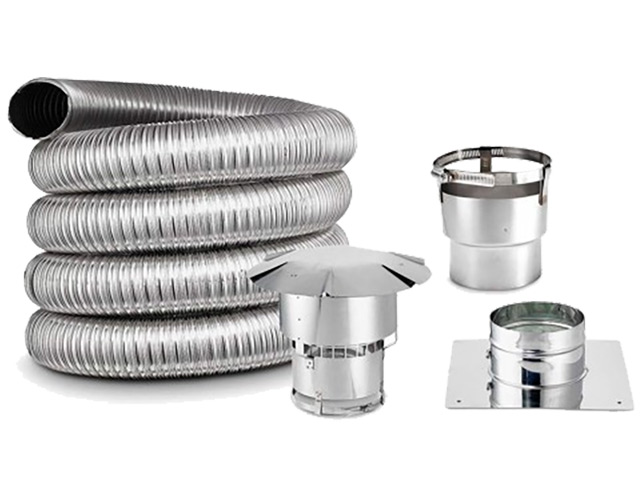Posted by Jeffrey Swerdan on Jul 27th 2023
Why Should I Install a Chimney Liner
This Article has been approved by our on staff NFI Certified Specialists & Master Hearth Professionals.
A Chimney Liner is a great option for many homeowners. There are several factors that make choosing a chimney liner the preferred venting option, including improved safety and efficiency as well as giving the homeowner the flexibility to switch fuel types down the road.
What is the purpose of a chimney flu liner?
A chimney liner, sometime also called a flue liner is a protective channel that goes through your chimney cavity, connecting at your appliance and traveling up and out of your chimney structure. The main purpose is to carry flue gases and the by products of combustion.
Chimney liners work for wood stoves, pellet stoves, fireplaces, and gas appliances such as furnaces and water heaters
Chimney liners, such as our Flexible Chimney Liner Kits, are designed to work on a variety of appliances and fuel types. There are liners that are designed to work with wood burning units, gas units, pellet burners and even oil based fuel types. The liners come in a variety of sizes from 3 inches up to 8 inches, allowing them to be suitable for a wide array of chimneys. The sizing and material will change the chimney liner costs.
Chimney liners usually come in kits and are made of two types of metal: Aluminum or Stainless Steel and can be rigid or flex liner kits.
Chimney Liners are made of either aluminum or stainless steel materials. Usually these materials are referred to by a number such as 304 or 316. This refers to the grade of materials used to manufacturer the chimney liners. The chimney liner costs will vary depending on which materials you choose to use and which is rated for your appliance and chimney structure.
Stainless Steel Chimney Liner Benefits
Stainless steel is the most common material used for flexible chimney liners due to its durability, corrosion resistance, and ability to withstand high temperatures. It is suitable for venting various fuel types, including wood, gas, oil appliances, and pellet units. Stainless steel liners are available in different grades, with higher-grade steel providing better resistance to corrosion and higher temperature applications. Additionally, some stainless steel chimney liners come with insulation, further improving efficiency and safety.
Aluminum Chimney Liners Benefits
Aluminum flexible chimney liners are an affordable alternative to stainless steel. They are lightweight, making them easier to handle during installation. Aluminum liners are primarily used for gas appliances, where lower temperatures are involved. They are not suitable for wood-burning applications or high-temperature exhaust gases, as aluminum has lower resistance to heat and can be prone to deterioration over time.

Chimney Liner
The advantages to a chimney liner is improved draft by sizing the liner to the appliance, hotter core temperatures, improved safety, easier cleaning, and longevity.
Shop NowBenefits of choosing a Chimney Liner
There are several reasons why choosing a chimney liner for your heating project could be a smart choice. Here are some reasons that people choose to install a chimney liner:
Improved safety: A properly installed chimney liner helps contain and direct the by products of combustion. These by products include creosote, soot, and carbon monoxide. The liner helps direct the by products out of your home. It also helps reduce the risk of dangerous gases and particles seeping into your living space. Which helps give you peace of mind that you and your family are protected from potential health hazards.
Reduced fire hazard: A chimney liner minimizes the risk of chimney fires. Creosote is a by product of wood burning units and when left untreated can become a highly flammable substance that forms and sticks to the chimney walls. A chimney liner acts as a barrier, reducing the likelihood of creosote buildup on the chimney walls, and thus decreasing the risk of a potential chimney fire.
Enhanced draft and efficiency: A properly sized chimney liner can improve the draft of your fireplace. The chimney liner ensures that a smooth flow of air and exhaust gases flows properly out of the chimney. This, in turn, enhances the efficiency of heating appliances such as wood stoves and fireplaces. With the added efficiency it helps safe you more money on your heating bills.
Structural protection: The flu liner also protects the chimney's masonry walls from the corrosive effects of combustion byproducts. Over time, the acids and chemical makeup in these byproducts can damage the chimney walls, leading to expensive repairs. A chimney liner provides a protective barrier between the corrosive gases and the chimney structure, thus helping to extending the life of the chimney structure.
Code compliance: In many areas across the nation, building codes require the installation of a chimney liner when installing or replacing heating appliances. It is essential to make sure that your chimney system meets local building regulations. Failing to meet these regulations can cost you a variety of legal issues and potential penalties that will cost you more money. These regulations are in place to ensure that your project is safe for you and your family. It is always a good idea to check what the codes and requirements are for your area before beginning the project.
Fuel flexibility: A lot of chimney liners and chimney liner kits are designed to work with multiple different fuel types. If you decide to change your heating appliance down the road, having a properly sized chimney liner with different fuel ratings allows for more flexibility in choosing a new appliance in the future. You will always want to check manufacturer specifications and requirements to make sure your current chimney liner will work with the new appliance type you are wanting to purchase.
Cost-effective solution: Installing a chimney liner is an investment and sometimes it may seem that the upfront costs are more than you were thinking. Chimney liners offer a variety of benefits that help you save money throughout the life of the liner. Some of those benefits include improving the efficiency of your heating system, which allows you to burn less fuel and in turn saves you money on energy bills and fuel supplies. Other added benefits include preventing costly chimney repairs and reducing the risk of chimney fires.
With all of the benefits listed it is easy to see why choosing a Chimney Liner can pay for itself over time and add peace of mind and protection to your home heating project.
How long will a chimney liner last?
Chimney liners are designed and built to last a long time. Northline Express even offers a Lifetime brand Chimney Liner kits that come with a hassle free, no fine print, lifetime warranty. Check out the selection of Lifetime Chimney Liners.
How do I know if my current chimney structure is lined?
Determining whether your chimney is lined requires a visual inspection or the expertise of a professional chimney inspector. You can use a flashlight and look up the chimney flue from the fireplace or stove opening. If you can see masonry or bricks directly then most likely your chimney is not lined. If you can see metal tubing or a visible liner, then it contains a chimney liner.
If you can not get a visual from looking up through the appliance, then you can also check at the top of the chimney run on your roof. Just remove the chimney cap if you have one and use a flashlight to look down and inspect the chimney. You will be visually be able to see a metal tube or liner inside of the chimney cavity. It is common in older chimney systems to not have a liner.
If you're still having trouble determining, then you can always consult a certified chimney inspector or professional chimney sweep. They have specialized tools and video equipment that can examine the interior of the chimney flue. This also helps because at the same time they can inspect the stability of the chimney structure and give advice on whether a chimney liner is the best solution for your project.
Is a chimney liner the same as a flue/flu liner?
The terms chimney liner and flue or flu liner are used interchangeably in most cases. A chimney liner is a protective channel that helps guide combustion byproducts safely from your appliance and up and out of your chimney.
What size chimney liner do I need for my project?
When determining the size of the chimney liner you will need it all depends on several factors. Those factors include: the type of fuel-burning appliance you have, the size and type of your chimney, and the local building codes and regulations. Check out this article for more information on theMeasurements & Tools Needed for a Chimney Liner
How to insulate chimney liner or do I need an insulated liner?
Chimney liners can be insulated, and in many cases, it is highly recommended to have an insulated chimney liner, especially for certain heating appliances and fuel types. Insulating the chimney liner offers several benefits, including improved draft, increased safety, and enhanced efficiency.
Some Chimney Liner Kits come with insulation already attached where as with some others you can purchase an insulation kit and install it onto your chimney liner. Check out ourChimney Liner Insulation Options.
How much does it cost to install a chimney liner?
The cost of installing a chimney liner can vary based on your current set up as well as a number of other factors. Some of the factors that can affect the pricing include the type of liner you want to install, the type of appliance you are wanting to connect the liner to, the overall width, length and height of the chimney structure, the local labor rates, and any additional work that may be required to make your chimney structure safe. On average, the cost of installing a chimney liner can range any where from $1,500 to $5,000 or more.
It is recommended to have your chimney structure inspected either by a certified chimney inspector or a professional chimney sweep. These companies can use specialized video equipment as well as industry knowledge to let you know if your current chimney structure is in tact or in need of repairs. They would be able to help you determine if a chimney liner is a good option for your project and could help let you know if there may be hidden damage that you were unaware of.
Where can I find more information on Chimney Liners?
Check out our Resource Center for helpful articles and information. Here are some of our articles about chimney liners:

